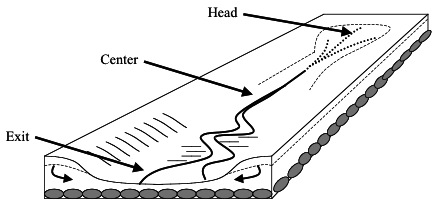Inland Valleys
The wetlands in Sub-Saharan Africa include coastal plains (deltas, estuaries and tidal flats), inland basins (comprising extensive drainage depressions), river floodplains (consisting of recent alluvial deposits bordering rivers) and inland valleys. Inland valleys are defined as flat-bottomed, relatively shallow valleys; they are widespread in the undulating landscape. They are known as dambos in eastern and central Africa, as fadamas in northern Nigeria and Chad, bas-fonds or marigots in francophone African countries, and as inland-valley swamps in Sierra Leone (Andriesse, 1986).
Inland valleys are characterized by their upstream position relative to a hydrological network. The edges of the valley are called fringes. The hydromorphic fringe or zone refers to the area close to the valley bottom where the groundwater table is sufficiently shallow to be within reach of crops. The catchment area captures the water of the whole hydrological network of an inland valley, from the crest (upland area, without groundwater-table influence on crop growth) through the hydromorphic zone (with shallow groundwater table) to the inland-valley bottom (usually flooded in the wet season).

To understand how an inland-valley lowland functions, one shouldn’t forget it belongs to a catchment area and a hydrological network. This is important for several reasons:
-
The position of the inland valley in a hydrological network has consequences for its sustainable development, ensuring a good integrated management of the watershed.
-
The inland-valley lowland is just one part (although a very important one) of the inland valley.
-
A good knowledge of the hydrological functioning of the catchment area will help in the management of the inland-valley lowland.
-
The management of the other land units in an inland valley (upland, hydromorphic zone) has direct implications for the sustainable use of the valley bottom.
The following concepts should be defined accurately: hydrological network, catchment and inland-valley lowland.
Hydrological network
‘Hydrological network’ is a general term used to describe the whole area occupied by several catchments or watersheds linked to each other by a drainage network. A drainage network is composed of several small streams (perennial or seasonal) that flow into a river downstream.

A typical hydrological network has many watersheds and wetlands of different sizes, which can be classified according to different orders. These orders run generally from one to four, the watersheds of the first order being upstream and the watersheds of the fourth order downstream.
-
A first-order inland valley is located at the beginning of the network, which means that there are no other inland valleys draining into it. These valleys are typically located upstream in the hydrographical network, but they can also be found further downstream if their water flows into a valley of a higher order. Such valleys are generally narrow with concave lowland fringes and a drainage pathway that is not well defined. Valley-bottom soils are often sandy loams.
-
A second-order valley receives water from at least one first-order valley. Second-order valleys are generally situated further downstream than first-order valleys and they are usually somewhat wider. A seasonal stream may be visible in the center of the inland-valley bottom. The slope (or hillside, i.e. distance between the crest and the inland-valley bottom) is longer and more pronounced than those of first-order valleys.
-
A third-order valley receives water from first- and second-order inland valleys. Third-order valleys are situated further downstream and are wider, with longer slopes. The inland-valley soils are deeper and more clayey. Depending on the degree of embranchment of the stream, there may be valleys of the fourth or fifth order.
The inland-valley catchment area
The inland-valley catchment area covers the space between the crests and the inland valley, and includes the landscape drained by a smaller valley into the valley in question. Catchments range in size from 100 to 2000 ha, depending on local topography. Their draining canals are oriented transversally to the slopes and longitudinally along the valley or stream. The inland-valley catchment area is the smallest unit of the hydrological network.
The catchment is composed of several elements that are defined by their hydrology and ecology in a continuum from the hillcrest, the slope, down to the bottom of the inland valley. The most important elements of the toposequence of a small valley are the upland area, the hydromorphic fringe and the valley bottom.
-
The upland area (strictly rainfed zone). This comprises the hillcrest and the higher parts of the inland-valley slopes. This area is characterized by the risk of lack of water. Rainfall is the only water supply for the crops, as the groundwater table does not get near enough to the root zone. Soils are relatively coarse-textured and get wet only during the rainy season. Small stones, gravel, iron concretions or stone blocks can hinder crop management practices such as plowing. Traces of water erosion due to run-off can usually be observed, e.g. sand deposits at the bottom of the slope, or gullies along the slope.
-
The hydromorphic fringe (groundwater zone). The hydromorphic zone covers the transition between the valley bottom and the upland. Rain and capillary rise of groundwater are the major water sources for the crops grown in this zone. The groundwater table is fed by subsurface groundwater flow from the slope and from infiltration of surface water. The hydromorphic fringe is often used to grow vegetables.
-
The valley bottom (fluxial zone). This zone is characterized by water saturation and is often flooded in the wet season. Water is provided by rain, run-off and subsurface flow from the uplands and fringes, and drainage from inland valleys further upstream. The period of flooding depends on several factors, e.g. frequency and intensity of rainfall, inland-valley shape, types of soil in the watershed, type and density of vegetation in the upland area and hydromorphic fringes. During flooding, one can often observe stains on the water that resemble oil spills—these are due to the presence of high concentrations of iron (Fe) in the floodwater. This may mean that Fe concentrations may be toxic to rice (see Reference 4). Sandy patches can be found at the border of the inland-valley lowland because of erosion from the uplands.

Representation of a longitudinal transect in a small valley, showing its head (upstream), center and exit (downstream)
Type of inland valleys and valley bottom
There are three types of inland valley (Andriesse, 1986):
-
Narrow valleys with relatively steep and straight to convex side-slopes, occurring in relatively hard rocks (such as granite and quartz)
-
Intermediate valleys with moderately steep, concave side-slopes, in moderately hard rocks (such as schists)
-
Wide valleys with gentle, concave side-slopes, in relatively soft formations (such as sedimentary rocks).
Two main types of valley can be recognized on the basis of hydrologic characteristics (Andriesse, 1986):
-
Stream-flow valleys in the uppermost parts of the river catchments (low-order valleys). Apart from rainfall, runoff and seepage from the adjacent uplands are the main water sources. These valleys have a poorly defined, more or less centrally located, shallow stream channel, which does not exist in the upper parts. The flat bottoms of the valleys vary in width from about 10 m in the upper portions to about 100 m in the lower stretches. Catchment sizes vary from 2–5 km2 on granitic formations to 20–50 km2 on sedimentary rocks
-
River-overflow valleys, downstream of the stream-flow valleys. These valleys have a distinct stream channel that, in general, is located at one side of a small floodplain (up to 200 m wide) in the valley bottom. The main water source is overflow from the river, rather than runoff or seepage.
Soils of the valley lowlands vary widely in their characteristics, both within and between valleys, ranging from sand to clay. In general, however, textures of the soils, as well as their chemical characteristics, reflect the soils of the surrounding uplands and the parent material from which they are derived (Andriesse, 1986). Thus, broadly generalized, coarse infertile soils prevail in valley bottoms of poor and acid rocks (sandstones, granite) and medium to fine, relatively fertile soils are found in valley bottoms of areas with rich parent rocks (such as shales, siltstones, basalts).
Extract from PLAR-IRM Curriculum: Technical Manual (Wopereis, 2009).













